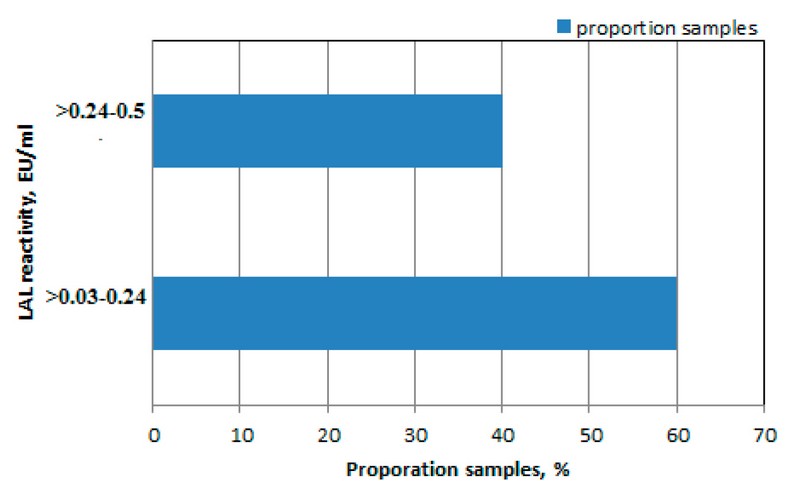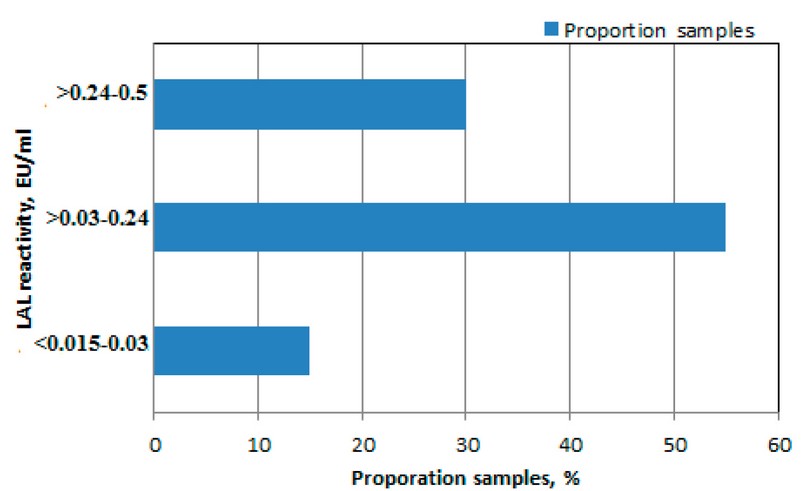2023.08.01.38
Files > Volume 8 > Vol 8 No 1 2023
Assessment of endotoxin levels of water in hemodialysis centers in Iraq
1Environment and Water Directorate, Ministry of Science and Technology, Baghdad, Iraq;
1Environment and Water Directorate, Ministry of Science and Technology, Baghdad, Iraq, [email protected].
Corresponding author* [email protected], 009647903265918.
Available from: http://dx.doi.org/10.21931/RB/2023.08.01.38
ABSTRACT
The significance of endotoxin-free, sterile dialysis fluid for long-term, high-quality hemodialysis treatment is obvious and highly desired[MF1] . The current study aimed to determine endotoxin for the water quality used in twenty hemodialysis treatment centers. Eighty samples (40 x dialysates and 40 x dialysis water) were tested for endotoxin using the LAL gel clot method. The results revealed a variation in the quality of the produced water that makes it unaccepted compared to the international standard (ANSI/AAMI/ISO-23500). Endotoxin levels were higher than (0.25 EU/ml) in 40% of dialysis water and 30% of dialysate water, higher than the recommended international standards. The results conclude that systematic water quality monitoring in hemodialysis services is essential for patient safety and health problems.
Keywords: Endotoxin; Water quality; Dialysis fluid; LAL test; Hemodialysis patient
INTRODUCTION
Water quality is critical for hemodialysis because contaminants in the water can enter the patient's bloodstream and cause significant morbidity and mortality. 1 Chronic inflammation is widespread among dialysis patients but has been linked to poor water quality.2 To that end, dialysis water is extensively pretreated before use, and most dialysis machines are equipped with endotoxin-retentive filters. One contaminant frequently linked to dialysis water contamination is lipopolysaccharide or endotoxin, which is released primarily from disintegrating gram-negative bacteria GNB.3 As a result, to prevent the growth of GNB in dialysis systems, dialysis machines must be disinfected regularly and a monitoring program established.4
The inappropriateness of tap water for a long time is recognized for hemodialysis treatment. The water utilized in hemodialysis centers undergoes additional treatment to decrease pollutants to levels required by national or international standards for dialysis fluids.5 Although the water treatment stations used in hemodialysis units depend on the quality of the drinking water and the uses of the treated water within the dialysis centers,6 the primary water treatment for the hemodialysis session is divided into three stages. The pretreatment stage's first step removes most suspended particulates, organic matter, and cations (sand filter, softener, brine tank, and carbon filter). The second treatment stage aims to remove any remaining chemical compounds and microbiological contaminants (reverse osmosis). The third stage, known as post-treatment, seeks to ensure that water is distributed to the monitors while considering that circuit designs with external curvatures encourage water stagnation, which can lead to contamination.7
Recently, the American National Standard Institute (ANSI), Association for the Advancement of Medical Instrumentation (AAMI), and the International Organization for Standardization (ISO) released recommendations for water and dialysis solutions, intending to suggest reasonable procedures for dialysis fluid production and monitoring.3 Following these guidelines will result in an improvement in dialysis fluid quality. Endotoxin concentration is expressed as Endotoxin Units (EU). Endotoxin content in dialysis water (reverse osmosis water) must be less than 0.25 EU/ml, while the maximum guideline concentration in dialysate water is less than 0.5 EU/ml. In ultrapure dialysate, the guideline concentration is 0.03 EU/ml.8 Iraq has no national standard for dialysis fluid quality; therefore, the above international criteria will be used to audit and monitor endotoxin content and water quality used to prepare dialysis fluid . This national study aimed to determine the endotoxin level in dialysis water and dialysate in Iraqi hemodialysis centers.
MATERIALS AND METHODS
Work strategy and sampling
The hemodialysis water examined in this study were samples collected for endotoxin analysis during 2021-2022 in 20 Iraqi hemodialysis centers. A total of 80 water samples were analyzed; 40 were examples of dialysis water (reverse osmosis) and 40 samples of dialysate water.
The samples were collected in a sterile, endotoxin-free bottle (100 ml) pre-prepared before sampling in the laboratory. Samples were transported immediately on the same day to the laboratory for testing.
Endotoxin test
Limulus amoebocyte lysate (LAL) and a gel clot were employed to quantify endotoxin in the dialysis fluid. The sensitivity of the measuring kit is (0.015 EU/ml and 0.06 EU/ml).9 The examination process includes mixing 0.1 ml of dissolved LAL reagent into the appropriate reaction tube, adding 0.1 ml of the sample, and incubating it using a water bath at 37 ± 1 °C, 60 ± 2 minutes without subjecting it to vibration. When incubation is complete, tilt the tube through 180° immediately but gradually. If a gel forms and maintains its integrity without deformation or collapse, the result is positive; if no gel forms, the effect is negative. Samples were analyzed twice using different dilutions.
Statistical analysis
Data analysis was done with Microsoft Excel 2010.
RESULTS
Figures 1 and 2 showed hemodialysis centers' endotoxin levels in dialysis water (n=40) and dialysate (n=40). Endotoxin levels ranged (from>0.03- 0.5 EU/ml (in dialysis water and )<0.015 - 0.5 EU/ml) in dialysate samples. The level of endotoxins was >0.25 EU/ml in samples of dialysis water (n=24) and dialysate (n=22) samples. Overall, the endotoxin level was less than 0.25 EU/ml in 60% of the dialysis water samples and 70% of the dialysate samples. As a result, only those samples complied with the (ANSI/AAMI/ISO) best practice requirements for pure dialysis fluid. Only five Iraqi hemodialysis centers complied with the definition of the (ANSI/AAMI/ISO) best practice limits for ultrapure dialysate.
The dialysis water and dialysate were of poor quality (the level of endotoxin was more significant than 0.25 EU/mL) in 40% and 30% of hemodialysis centers, respectively.

Figure 1. Endotoxin levels in dialysis water of several hemodialysis centers in Iraq

Figure 2. Endotoxin levels in dialysate of several hemodialysis centers in Iraq
DISCUSSION
The current study is a national survey of the quality of dialysis fluid. Iraq had more than 20 hemodialysis centers in 2021 (according to the Iraqi annual statistical report). 10 The first attempt to study the quality of dialysis fluid in Iraq was conducted by Al-Naseri et al. It was a small study looking for endotoxin levels in dialysis fluids.11
The results showed high in 50% pure dialysis and 13% ultrapure hemodialysis water. These endotoxin levels did not comply with international guidelines. 8 This result is consistent with the results of Penne EL et al. 2009 12 who confirmed that the ultrafiltration technology might generate online dialysis fluids for an extended period while maintaining consistent quality.
Endotoxin levels in dialysis fluid indicate that the water treatment procedure may be a source of endotoxin contamination.13 It would be necessary to change the water treatment unit's architecture to include a different phase of controlled ultrafiltration that produces sterile, pyrogen-free fluids suited for infusion.
Excess endotoxin in dialysis fluid from Gram-negative bacteria can produce pyrogenic responses and septicemia.2 As a result, endotoxin in treated water is a cause for worry in hemodialysis institutions and should be considered when assessing the quality of hemodialysis water. This might be viewed as a potential restriction, given the study's primary goal was not to evaluate clinical symptoms of endotoxemia and inflammatory reactions, which could be investigated further in future studies. This problem was previously addressed in determining the level of endotoxin in hemodialysis patients and its function in generating inflammation. 14,15-,16
CONCLUSIONS
Dialysis water should consider a medicinal product by nephrologists. Furthermore, every effort should be taken to guarantee a high-quality liquid. To avoid the formation of bacterial endotoxins, regular disinfection of the entire fluid path is essential, and endotoxin testing should be included in the standard quality control survey.
Acknowledgments
The authors are thankful to assist the Iraqi Ministry of Health in auditing water quality and improving dialysis safety and quality in their institutions.
Conflict of Interest
The author has no conflicts of interest to declare.
REFERENCES
1. Ahmad, S. Essentials of water treatment in hemodialysis. Hemodialysis International. 2005; 9(2) 127-134.
2. Coulliette, AD. and Arduino, MJ. Hemodialysis and water quality. In Seminars in dialysis. 2013; 26(4) 427-438.
3. Miyamoto, T., Okano, S. and Kasai, N. (2009). Inactivation of Escherichia coli endotoxin by soft hydrothermal processing. Applied and Environmental Microbiology; 2009;75(15). 5058-5063.
4. Humudat, YR., Al-Naseri, SK. and Al-Fatlawy, Y. Assessment of microbial contamination levels of water in hemodialysis centers in Baghdad, Iraq. Water Environment Research; 2020; 92(9)1325-1333.
5. Hoenich, NA. Disinfection of the hospital water supply: a hidden risk to dialysis patients. Critical Care. 2009; 13(61-2.
6. Humudat, YR. Evaluating dialysis fluids properties and its effects on hemodialysis patients at several hospitals in Baghdad. Thesis. Collage of science-University of Baghdad .2020.
7. Gaibor NG, Sacaluga LG, de la Cerda Ojeda F, Cotén JR, Lazo MS. Thermal disinfection in hemodialysis using the A0 concept as dispenser. Nefrología (English Edition). 2019;39(5):482-8.
8. ANSI/AAMI/ISO 23500. American National Standard Institute:Preparation and quality management of fluids for haemodialysis and related therapies. Arlington, Virginia: Association for the Advancement of Medical Instrumentation. 2019.
9. Wako-pyrostar. <85> Bacterial endotoxin test. 2012; 1-36.
10. Iraqi Ministry of Health. . Annual statistical report 2019. Republic of Iraq, Ministry of Health and Environment. 2020; 1-202.
11. Al‐Naseri, SK., Mahdi, ZM. and Hashim, MF. Quality of water in hemodialysis centers in B aghdad, I raq. Hemodialysis International. 2013;17(4) 517-522.
12. Penne EL, Visser L, Van Den Dorpel MA, Van Der Weerd NC, Mazairac AH, Van Jaarsveld BC, Koopman MG, Vos P, Feith GW, Hovinga TK, Van Hamersvelt HW. Microbiological quality and quality control of purified water and ultrapure dialysis fluids for online hemodiafiltration in routine clinical practice. Kidney international. 2009 ;76(6):665-72.
13. Skarupskienė, I., Bumblytė, IA., Tamošaitis, D., Venterienė, J and Kuzminskis, V. The level of endotoxins in hemodialysis water and dialysate in Lithuanian hemodialysis centers. Medicina,. 2010; 46(8) 556-560.
14. Abbass, AA., El-Koraie, AF., Hazzah, WA., Omran, EA., and Mahgoub, MA. Microbiological monitoring of ultrapure dialysis fluid in a hemodialysis center in Alexandria, Egypt. Alexandria journal of medicine.; 2018; 54(4) 523-527.
15. Humudat, YR., Al-Naseri, SK. and Al-Fatlawy, YF. Assessment of inflammation, comorbidity and demographic factors in patients with Kidney disease in Baghdad. Iraqi journal of science.; 2019; 60,2418-2425.
16. El-Koraie , AF., Hazzah , WA., Abbass , AA., and El-Shazly, SA. Bacteriological monitoring of dialysis fluid in 2 hemodialysis units in Alexandria, Egypt. Saudi medical journal. 2007; 28(8),1234.
Received: December 23, 2022 / Accepted: January 30, 2023 / Published:15 February 2023
Citation: Raad Humudat Y, Kadhim Al-Naseri S. Assessment of endotoxin levels of water in hemodialysis centers in Iraq. Revis Bionatura 2023;8 (1)37. http://dx.doi.org/10.21931/RB/2023.08.01.37
